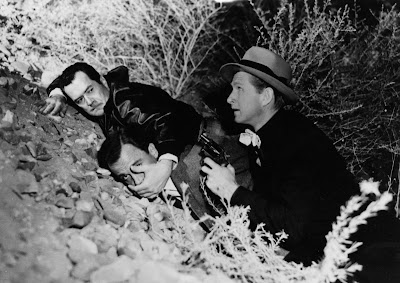In what might be one of the most brutal sequences in film noir history, the prison assault at the end of The Sound of Fury remains unforgettable, decades after its theatrical release in 1950. The source subject, the 1933 Brooke Hart incident in San Jose, was also covered in Fritz Lang’s film, Fury, in 1936 with Spencer Tracy in the lead. The film would later be re-titled and re-issued as Try and Get Me, now available commercially on DVD.
The unemployed Howard Tyler (played by Frank Lovejoy) is desperate for a job since he is married with a wife and son, and his wife reveals she is pregnant. When he meets the "bon vivant" Jerry Slocum (played by Lloyd Bridges), the stranger offers Howard a job. It does not take long for Howard to discover Jerry is a small-time thief, robbing convenience stores, and his job would be to drive the getaway car after the heist. For a few weeks, crime does pay and Howard improves the life of his family with his new found fortune. He fibs to his wife about working the night shift at a factory.
Meanwhile, a journalist named Gil Stanton (played by Richard Carlson) works for a newspaper and through strong insistence of his boss, the editor-in-chief, Stanton is asked to cover the rash of crimes in his daily column. But, as the editor discovered fear and anger sells more newspapers, he encourages his employee to write “editorials” which, even in a journalistic field is the equivalent to “news commentary.” Profits grow for the newspaper, as does circulation numbers.
When Jerry kidnaps the son of a millionaire, he brutally kills the man and forces Howard to help him to dump the corpse in the sea. Jerry even writes a ransom note to the family. When the body is found, Stanton incites the population in his columns citing the abductors are “monsters.” Howard breaks down, due to too much alcohol, and is promptly apprehended – as is Jerry. While Howard and Jerry remain behind bars to face a courtroom, Stanton’s editorials suggest the men will get away with murder and walk away free – demanding justice. This prompts the town citizens to protest in the streets, breaking down the doors to the local precinct, killing police, stealing guns and brutally murdering Howard and Jerry.
Mob violence provided the springboard for this shocking but gripping account of mass hysteria not as a result of the crime spree, but the news media that was designed to incite and infuriate their readers.
Cy Endfield and Jo Pagano wrote the screenplay, adapted from Pagano’s novel, The Condemned. For mystery buffs, Pagano is not an unknown name. For film buffs, the movie provides a number of treats: filmed on location the Phoenix area, an early screen appearance by Yvette Vickers, and the film debut of Joe E. Ross performing his popular nightclub act with Frank Lovejoy as the foiled audience member. The film had a rocky distribution and reportedly Martin Scorsese owned the only remaining 35mm print. Thanks to Scorsese, the film went through a major restoration and a new print was struck in 2013.
A few months ago my wife and I went to see The Forever Purge (2021), a dystopian horror movie about a battered nation that decides murder should be legal for twelve number of hours, with federal approval. The “purge,” however, was not for a limited time. Fueled by countless social media feed, dark web conspiracies and the news media spewing hatred about our next door neighbors and fellow Americans, the bloodshed never ends. The country burns to the ground and the final chapter in the history of the United States comes to a close. In a movie review I mentioned, sincerely, that The Forever Purge was the scariest film I have seen in a decade. Just a few months later, watching Try and Get Me (1950), I can now say I have seen the second scariest movie in the last decade.
Fans of film noir may want to catch this movie, even though the movie has no trademarks commonly found in film noir: femme fatales, plot twists, etc. The pace is a tad slow but it builds momentum. Having watched over 300 film noir classics in the last decade, I am now forced to decide whether this goes on my top ten film list of must-see film noir. If not, it certainly deserves honorable mention.


